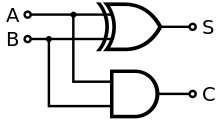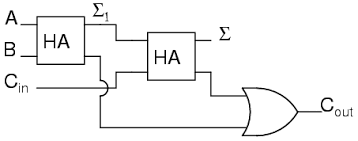This is a simple abstraction of Homomorphic Cipher - 4-bit adder. In this case we are adding a and b, where a and b can range from 0 to 15:
Homomorphic Cipher - 4-bit adder |
Theory
The code uses the DGHV (Dijk, Gentry, Halevi and Vaikuntanathan) scheme [paper] and which is a fully homomorphic encryption scheme [1]. First we get a random number (\(p\)) and two random numbers (\(q\) and \(r\)), and then encrypt a single bit (m) with:
\(c = p \times q + 2 \times r +m \)
In this case p will be our secret key.
If \(2r\) is smaller than \(p/2\), we cipher with \(\pmod p\) we get:
\(d = (c \pmod p) \pmod 2\)
We have basically added noise to the value with the q and r values.
With this function we can add (OR) and multiply (AND).
In this example we create an encrypted 4-bit add function:

A half adder is created with:

A full adder is created with:

For a Half-adder (HA), the logic is:
\(Sum=\bar{a}\cdot b + a \cdot \bar{b} \)
\(Carry=a + b \)
For a Full-adder (FA) we have inputs of a, b and \(C_{in}\), and which gives Sum and \(C_{out}\):
\(sum_1,c_1=HA(a,b)\)
\(Sum,c_2=HA(sum_1,cin)\)
\(C_{out}= c_1 + c_2\)
Code
The following is an outline and where I have used XOR, NOT, AND, HA and FA functions:
import sys
from random import randint
def tobits(val):
l = [0]*(8)
l[0]=val & 0x1
l[1]=(val & 0x2)>>1
l[2]=(val & 0x4)>>2
l[3]=(val & 0x8)>>3
return l
def XOR(a,b):
return ( (NOT(a)*b) + (a*NOT(b)))
def NOT(val):
return(val ^ 1)
def AND(a,b):
return(a*b)
def OR(a,b):
return(a+b)
def HA(bit1,bit2):
sum=XOR(bit1,bit2)
carryout=AND(bit1,bit2)
return sum,carryout
def FA(bit1,bit2,cin):
sum1,c1=HA(bit1,bit2)
sum,c2=HA(sum1,cin)
carryout=OR(c1,c2)
return sum,carryout
def cipher(bit,p):
q=randint(50000, 90000)
r=randint(1,200)
return( q * p + 2*r +int(bit)),q,r
val1=1 # Value 1
val2=2 # Value 2
if (len(sys.argv)>1):
val1=int(sys.argv[1])
if (len(sys.argv)>2):
val2=int(sys.argv[2])
v1=[]
v2=[]
v1=tobits(val1)
v2=tobits(val2)
cin=0
p =randint(3e23, 6e23)*2+1
c_carryin,q,r=cipher(cin,p)
print(v1)
print(v2)
cval1b0,q,r=cipher(v1[0],p)
cval2b0,q,r=cipher(v2[0],p)
cval1b1,q,r=cipher(v1[1],p)
cval2b1,q,r=cipher(v2[1],p)
cval1b2,q,r=cipher(v1[2],p)
cval2b2,q,r=cipher(v2[2],p)
cval1b3,q,r=cipher(v1[3],p)
cval2b3,q,r=cipher(v2[3],p)
print("1 ",c_carryin)
c_sum1,c_carryout=FA(cval1b0,cval2b0,c_carryin )
c_sum2,c_carryout=FA(cval1b1,cval2b1,c_carryout )
c_sum3,c_carryout=FA(cval1b2,cval2b2,c_carryout )
c_sum4,c_carryout=FA(cval1b3,cval2b3,c_carryout )
#decrypt
sum1 = (c_sum1 % p) % 2
sum2 = (c_sum2 % p) % 2
sum3 = (c_sum3 % p) % 2
sum4 = (c_sum4 % p) % 2
carryout = (c_carryout % p) % 2
print("Val1:",val1)
print("Val2:",val2)
print("\nResults")
print("Sum:\t\t",carryout,sum4,sum3,sum2,sum1)
A sample run for 10+3 is:
====Results Sum: 0 1 1 0 1 =====Values Val1: 10 Val2: 3 Val1: [0, 1, 0, 1, 0, 0, 0, 0] Val1: [1, 1, 0, 0, 0, 0, 0, 0] ============== CipherSum1: 1853413439219588680362570004035539833199755116203941462387881614051069375577231539520832 CipherSum2: 18432088486623813969980647304350337154711815732175283443172417318749729314891009826471766488723050656491638014592763859568974471673016023927866810 CipherSum3: 350105144711158283115794663725335113049840194441122465890305291670175445319366318657618638280532769541121410516476447411821501389646124250137985987070461181752715150777041165828342101068104481973550579462 CipherSum4: 3995391850663852786441324241749498886121148237476111383649056346858553730949171138764761675781807650455657359442677684602690077760551518453319562392807728988377765423915052651245069195389895502097424541686398830447980094072881739759138034496479585192950087562392
Presentation
Here is a presentation on the method used:
Reference
[1] M. van Dijk, C. Gentry, S. Halevi and V. Vaikuntanathan, "Fully Homomorphic Encryption over the Integers". Proceedings of Eurocrypt 2010.